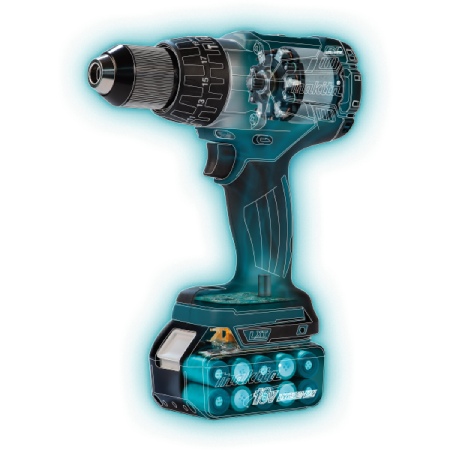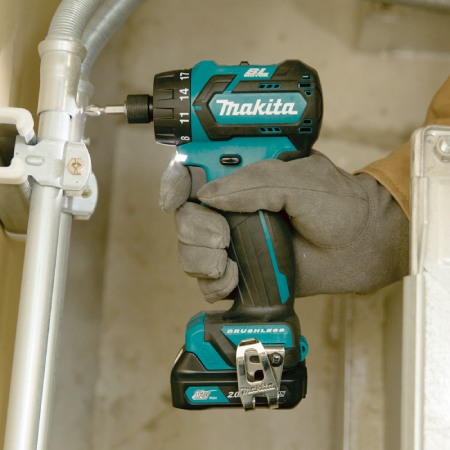The CXT tools belong to the compact 2lb range, while the LXT group hovers around the sub-compact 3lb class. The 12v CXT series is renowned for its ease of use, decent performance, and a lower price range. They are a fantastic match for homeowners and hobbyists.
On the other hand, 18v LXT packs are all about versatility suited for industrial applications. They produce nearly twice as much power as their CXT cousins and are a perfect pick for professionals.
Let’s dig deeper and see which battery technology triumphs.
Makita CXT vs LXT: How They Differ

-
Size & weight
-
-
Makita CXT
-
No doubt the CXT battery is a great compact design with dimensions of ?1.63” x 2.38” x 2.38”. A single CXT unit weighs ?13.6 ounces only.
-
-
Makita LXT
-
It’s actually wrong to call the LXT “bulky” considering the level of convenience it comes with. They are ?3” x 6.75” x 9.75” in dimensions and weigh 2.83 lbs.
-
-
Winner
-
Numbers don’t lie. When it comes down to picking a winner, CXT has a clear edge in size and weight when compared to LXT.
-
Performance
-
-
Makita CXT
-
The CXT line offers lower self-discharge and delivers an extended run time. ? The optimization for brushless motors makes them great power drive systems. The 4000mAh CXT seems perfect for DIYers.
-
-
Makita LXT
-
The LXT 18v is available in 3,4,5, and 6-amp hour options. It offers a low self-discharge time and can pair up with one more 18v battery to work with 36v machines. This is the battery to suit you from short work to going all day and you can be assured of your battery not deteriorating any time soon.
-
-
Winner
-
CXT is no match for LXT when it comes to performance. Some LXT models deliver twice as much power as the CXT lineup. LXT is the first choice if you’re looking for excellence in professional applications.
-
Versatility
-
-
Makita CXT
-
CXT tools are compact and comfortable at hand. They’re lightweight, easy to operate, and can get along with 30 plus tools that use the same 12-volt packs. You can get them in both 2 and 4-amp hours. One of their special features is that they are able to operate in extremely low temperatures.
-
-
Makita LXT
-
275 plus Makita tools operate through the same 18v LXT batteries. It didn’t stop there; you can actually combine two 18v LXT packs to power up a number of 36v tools. It seems that you’ll never be out of options for using an LXT.
-
-
Winner
-
LXT remains an unbeatable champion with more than 275 different tools in the lineup as the choices of work. With LXT, you may get a battery pack that lets you get along with many of your tools without having to spend on new batteries and chargers
-
Price
-
-
Makita CXT
-
As of 2022, a brand new CXT pack would cost you around $25 or more depending on the options you choose. This is comparably half of what a new LXT pack will cost. So you’ll get a good amount of power with a fair amount of price from a brand you can trust.
-
-
Makita LXT
-
A new LXT pack will cost you around $50 or more depending on the variant you get. They’re the costlier of the two. This makes sense if you consider the high voltage and satisfactory performance.
-
-
Winner
-
CXT is the more affordable one. If you’re a hobbyist or a homeowner who likes to keep your gears handy, you may want to consider the CXT line of tools.
Makita Cxt: Pros and Cons

Pros
-
Slimmer and shorter tools
CXT tools are shorter and slimmer than pod-style LXT tools. They’re able to have perfect handles because of sliding battery packs.
-
Easy to hold compact tools
Makita claims that they’ve improved their design and come up with the best possible ergonomic handle with their CXT line of tools. Besides, they are appreciably compact.
-
Decent performance and affordable pricing
You’ll get an upright performance at a reasonable price as you choose CXT tools. You can’t go wrong with your next DIY project with CXT in your arsenal.
-
Lightweight
Lightweight tools help with precision and allow working longer hours by putting less pressure on your hands and shoulder muscles.
-
Great options if you have difficulty holding larger tools
You may go with the CXT line of tools if you find it difficult to hold heavier and larger devices while working on your projects.
Cons
-
Fewer volts, lesser power
Members of the CXT lineup are not compatible with the LXT clan in power. 12-volt batteries can’t just compete with 18-volt LXT packs. Fewer volts mean less power.
-
Limited choices
You’ll have fewer options with CXT as there are not many tools to support it. Going with CXT might not be a good idea when you have plans to expand your tool collection in the coming days.
Makita Lxt: Pros and Cons

Pros
-
More than 275 diverse tools
Outstanding diversity is the big advantage the LXT tools have. A staggering number of tools share the same 18v battery to operate; some of which you might already have in your collection.
-
18-volt for better power
18-volt offers a large amount of power when compared to 12-volt CXT. Some LXT tools are 100% more powerful than their equivalent CXT counterparts.
-
Multiple alternatives for each tool
You’ll have quite a few different models (with individual features and prices) to choose from within the LXT squad when you need a specific type of tool. The same can’t be said about the CXT tools on the market.
-
Withstands worksite abuse
LXT tools are more heavy-duty than CXT tools. Durability and long-lasting quality enable them to withstand worksite abuses better than their CXT cousins.
-
A pair of 18v LXT can run 36v tools
LXT is all about diversity and power. The batteries can be paired together, so you can use this option to run extremely powerful 36v machines.
Cons
-
High price
The price tag is LXT’s disadvantage for obvious reasons. A set of LXT can cost you around 100% more than what you’d pay for a CXT pack.
-
Bigger and bulkier tools
LXT tools may require strong muscles to operate since they’re heavy and unmanageable. You may not find them as easy to operate as CXT tools but they’ll be great when you need performance and diversity.
When should you try Makita CXT tools?
CXT is no better or worse than LXT when you thoroughly consider both of them side by side. CXT is the first choice for non-professionals such as DIY enthusiasts and homeowners. They’re lightweight, decently powerful, compact in girth, easy to handle, and they save you some cash.
The brushless motor and slide-style battery gave an edge to the CXT tools. They’re quite convenient to get your every DIY project done smoothly and efficiently. You can even take them to tight places and continue to work.
CXT tools particularly benefit you If you need to work in extremely low-temperature. You‘ll not come upon any drop in the performance at all.
When should you try Makita LXT tools?
LXT tools are the best companions of contractors. The versatile LXT saves you time and money as you perhaps don’t need to buy extra sets of batteries for many of your existing tools.
The performance, super-fast charging, and built quality allow you to work longer hours to get more work done. Their premium run time brings you a consistent result so you can solve problems, project after project.
When it comes to the power of LXT, you get an 80% to 100% increase compared to that of an equivalent CXT tool. Consider going with LXT if you’re a hardcore professional who likes to get things done in the best way possible.
FAQs:
1. Are all Makita 18V batteries interchangeable?
Ans: The 18v LXT Makita batteries are consistent with all LXT solutions with “Star Protection Computer Controls.” You may want to check your Owner Manual to learn if your particular unit is compatible with all Makita battery products.








